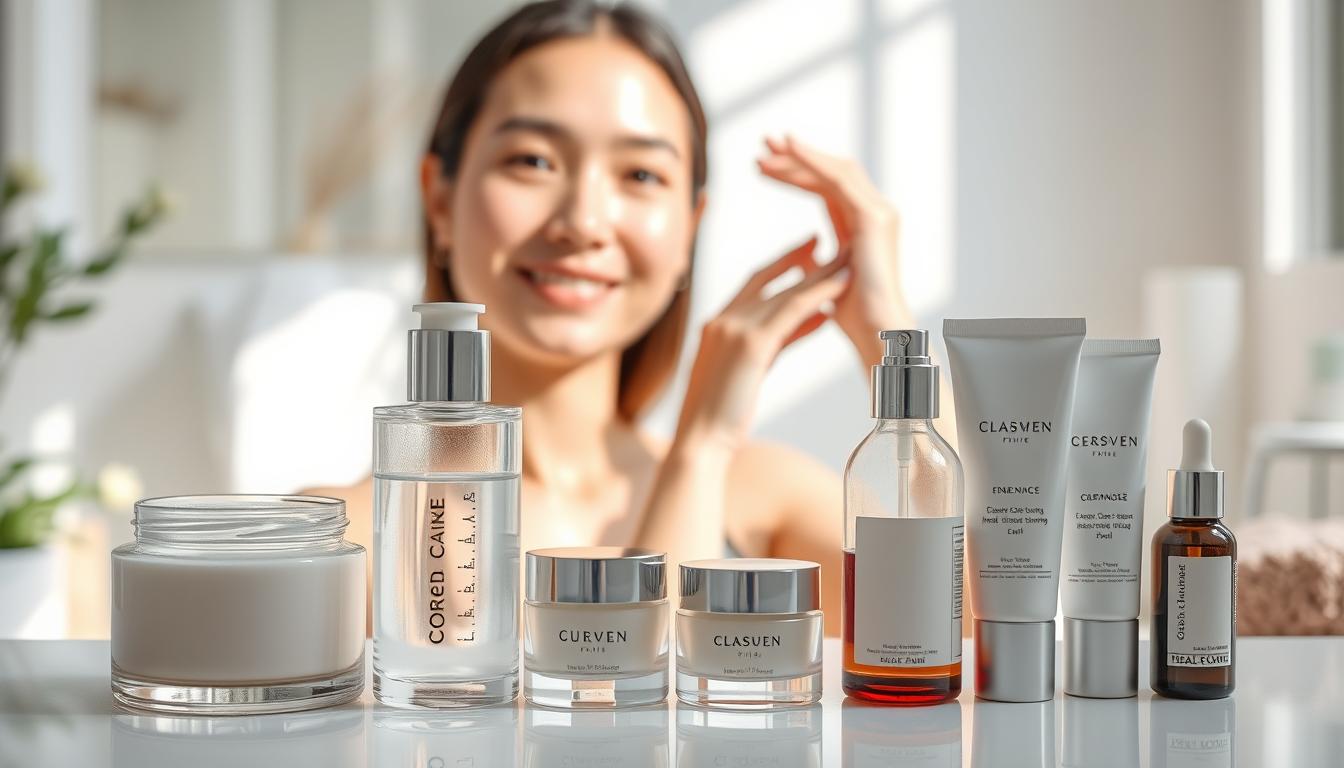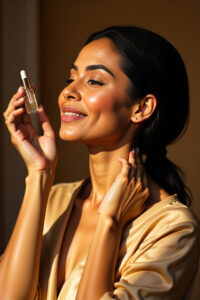Table of Contents
Have you ever wondered why Korean skin care routines are so effective? One of the secrets lies in a simple yet powerful technique called double cleansing. Originating in Korea, this method has become a cornerstone of K-beauty and has gained significant popularity in the US over the past few years.
So, what exactly is it? Double cleansing involves two steps: first, an oil-based cleanser to remove makeup, sunscreen, and impurities, followed by a water-based cleanser to deeply clean the skin. This two-phase approach ensures a thorough clean, leaving your skin fresh and ready for the next steps in your routine.
Celebrity estheticians like Shani Darden have helped popularize this method, and for good reason. Beyond just cleaning, double cleansing boosts product absorption and helps protect your skin from pollution. It’s a game-changer for anyone looking to elevate their skin care routine.
Throughout this article, we’ll dive deeper into the benefits and hear insights from dermatologists like Dr. Kim and Dr. Linkner. Ready to transform your skin? Let’s get started!
Key Takeaways
- Double cleansing is a two-step process combining oil-based and water-based cleansers.
- It originated in Korea and has become a staple in K-beauty routines.
- This method ensures a thorough clean, removing makeup, sunscreen, and impurities.
- It boosts product absorption and protects skin from pollution.
- Celebrity estheticians have helped popularize it in the US.
What is Double Cleansing?
How did a centuries-old technique become a modern skincare staple? The answer lies in the double cleanse, a method that ensures your skin is thoroughly clean and prepped for the rest of your routine. This two-step process removes everything from makeup to pollutants, leaving your skin refreshed and ready to absorb other products.

The Origins of Double Cleansing
The roots of this method trace back to 15th-century Japan, where geishas used an oil-based cleanser to remove their heavy white makeup. This practice evolved over time and was later popularized by Korea’s 10-step skincare routine. Today, it’s a cornerstone of K-beauty, known for its layered approach to achieving glowing skin.
How Double Cleansing Differs from Regular Cleansing
Regular cleansing often relies on a single product, which may not fully remove all impurities. In contrast, the double cleanse uses two specialized formulas. The first step breaks down makeup and sebum, while the second step deeply cleanses the skin. As Dr. Wu explains, “It’s like using dish soap after a grease-cutting spray—you ensure nothing is left behind.”
For those with sensitive skin, micellar water can be a gentler alternative for the first step. This method ensures your face twice gets the attention it deserves, leaving it clean and balanced.
The Benefits of Double Cleansing
What if one simple change could transform your skin’s health? The two-step method offers a range of benefits that go beyond just cleaning your face. It’s designed to remove impurities, protect your skin, and enhance the effectiveness of your skincare routine.
Deep Cleansing for a Healthier Complexion
This method removes up to 73% more pollutants than a single cleanse, according to a 2019 study by Seoul National University. The oil-based step dissolves stubborn sebum, sunscreen, and makeup that water alone can’t tackle. This ensures your skin is free from impurities that can clog pores and lead to breakouts.
Dr. Kim’s research shows that patients who adopted this routine saw 31% fewer blackheads. It’s especially beneficial for urban dwellers, as it provides a defense against pollution and environmental stressors.
Enhanced Absorption of Skincare Products
By thoroughly cleaning your skin, this method creates a “clean slate” for your products. Dr. Linkner observed that it prepares the skin for 40% better serum absorption. This means your $98 serums and moisturizers can work more effectively, giving you better results.
It also helps maintain your skin’s hydration levels. Proper cleansing prevents damage to the moisture barrier, ensuring your skin stays balanced and healthy.
| Benefit | Impact |
|---|---|
| Deep Cleansing | Removes 73% more pollutants |
| Product Absorption | Boosts serum effectiveness by 40% |
| Hydration | Protects the skin’s moisture barrier |
| Pollution Defense | Shields against environmental stressors |
How to Double Cleanse: A Step-by-Step Guide
Ready to master the art of a thorough skincare routine? This step-by-step guide will walk you through the process of using an oil-based cleanser and a water-based cleanser to achieve a deep clean. Let’s break it down into simple, actionable steps.
Step 1: Choosing the Right Oil-Based Cleanser
The first step is selecting an oil-based cleanser that suits your skin type. Look for products with emulsifiers, which help rinse away residue without leaving a greasy feel. Popular options like DHC Deep Cleansing Oil are excellent for removing makeup and sunscreen.
Consider the texture that works best for you. Balms are ideal for dry skin, while milks or oils are better for oily or combination skin. Always patch-test new products to ensure they don’t irritate your skin.

Step 2: Selecting a Water-Based Cleanser
Next, choose a gentle water-based cleanser to follow up. Products like CeraVe Hydrating Face Cleanser are perfect for this step. Avoid cleansers with harsh actives, as they can strip your skin of its natural moisture.
This step ensures that any remaining impurities are removed, leaving your skin fresh and ready for the rest of your routine. Remember, the goal is to cleanse, not over-dry.
Step 3: The Double Cleansing Process
Start by massaging the oil-based cleanser onto dry skin for about 60 seconds. This helps break down makeup, sunscreen, and sebum. Rinse with lukewarm water to avoid irritation.
Follow up with the water-based cleanser, gently massaging it into your skin. Rinse thoroughly and pat your face dry with a microfiber cloth. Finish with a toner to balance your skin’s pH.
| Step | Key Tips |
|---|---|
| Step 1: Oil-Based Cleanser | Use emulsifiers, massage for 60 seconds, rinse with lukewarm water. |
| Step 2: Water-Based Cleanser | Choose a gentle formula, avoid harsh actives, rinse thoroughly. |
| Step 3: Finish | Pat dry, use a toner, avoid over-rubbing. |
By following these steps, you’ll ensure your skin is clean, balanced, and ready to absorb your skincare products effectively. Avoid common mistakes like using hot water or skipping the toner to get the best results.
Who Should Double Cleanse?
Is your skincare routine tailored to your specific skin type? This two-step method isn’t a one-size-fits-all solution, but it can work wonders for many. Let’s explore who benefits most and who might need to approach it with caution.

Ideal for Oily and Acne-Prone Skin
If you have oily skin or struggle with acne, this method could be a game-changer. A 2019 trial by Dr. Wu found that 68% of acne patients saw significant improvement after adopting this routine. The oil-based step helps dissolve excess sebum, while the water-based cleanser ensures pores are thoroughly clean.
This approach also prevents over-drying, a common issue with harsh acne treatments. As Dr. Wu explains, “It’s about balancing the skin—removing impurities without stripping its natural moisture.”
Considerations for Dry and Sensitive Skin
For those with dry skin or sensitivity, this method requires a gentler approach. The American Academy of Dermatology (AAD) advises eczema sufferers to avoid it entirely. However, those with mild sensitivity can still benefit by limiting it to 2-3 times a week.
Seasonal adjustments are also key. In winter, opt for cream-based cleansers to avoid over-drying. During summer, a lightweight oil cleanser can help remove sweat and sunscreen without irritation.
| Skin Type | Recommendation |
|---|---|
| Oily/Acne-Prone | Use daily to manage sebum and prevent breakouts. |
| Dry/Sensitive | Limit to 2-3x weekly; opt for cream-based cleansers. |
| Eczema/Rosacea | Avoid; stick to a single gentle cleanser. |
“For sensitive skin, less is often more. Over-cleansing can disrupt the skin’s natural barrier.”
Ultimately, this method works best for those who wear heavy makeup or SPF 30+ daily. If your nightly routine involves these, it’s worth giving it a try. For others, a single cleanse might suffice.
Product Recommendations for Double Cleansing
Looking for the perfect products to elevate your skincare routine? We’ve curated a list of the best oil-based and water-based cleansers to suit every skin type and budget. Whether you’re dealing with acne, dryness, or just want a luxury treat, there’s something here for you.
Best Oil-Based Cleansers
Start with a gentle cleansing oil to break down makeup and impurities. For acne-prone skin, Hanskin Pore Cleansing Oil is a game-changer. It deeply cleanses without clogging pores. If you’re looking for luxury, Tatcha Camellia Cleansing Oil is a cult favorite for its silky texture and nourishing ingredients.
On a budget? The Inkey List Oat Cleansing Balm ($12) is a steal. It’s perfect for sensitive skin and removes even waterproof makeup. For combination skin, Then I Met You Cleansing Balm ($38) is a viral K-beauty pick that leaves skin soft and hydrated.
Best Water-Based Cleansers
Follow up with a foaming cleanser to ensure a thorough clean. Cetaphil Gentle Foaming Cleanser ($17) is a dermatologist-approved basic that works for most skin types. For sensitive skin, La Roche-Posay Toleriane Hydrating Cleanser is a gentle yet effective option.
If you prefer a cream-based formula, CeraVe Hydrating Cleanser is a top choice. It’s rich and soothing, making it ideal for dry skin. For normal skin, Youth to the People Superfood Cleanser is packed with antioxidants and leaves skin feeling refreshed.
| Skin Type | Oil-Based Cleanser | Water-Based Cleanser |
|---|---|---|
| Acne-Prone | Hanskin Pore Cleansing Oil | Cetaphil Gentle Foaming Cleanser |
| Dry/Sensitive | The Inkey List Oat Cleansing Balm | La Roche-Posay Toleriane Hydrating Cleanser |
| Combination | Then I Met You Cleansing Balm | Youth to the People Superfood Cleanser |
| Luxury | Tatcha Camellia Cleansing Oil | CeraVe Hydrating Cleanser |
Pro Tip: Apply your cleansing oil to dry hands before wetting your face. This ensures maximum effectiveness in breaking down makeup and impurities. Avoid formulas with SD alcohol or menthol, as they can strip your skin of its natural moisture.
Conclusion
Ready to give your skin the care it deserves? The double cleansing method is all about quality, not quantity. By focusing on thorough yet gentle cleansing, you can unlock glowing, healthy skin. Start by trying this routine 3x weekly and monitor how your skin responds.
After cleansing, follow up with a hydrating toner or serum to lock in moisture. This step ensures your skin stays balanced and ready for the next steps in your skin care regimen. Pro tip: Use any leftover cleansing oil on your neck and décolletage for extra nourishment.
According to an Allure reader survey, 83% of users reported glowier skin in just two weeks. Why not give it a try? Share your first double cleansing experience with us @BrandName—we’d love to hear how it worked for you!




